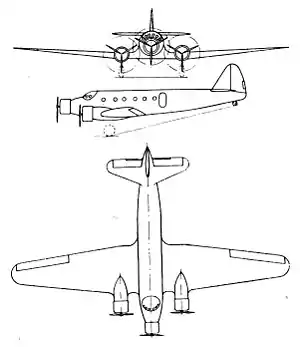| R.35 | |
|---|---|
 | |
| Role | Airliner |
| National origin | Belgium |
| Manufacturer | Renard |
| Designer | Alfred Renard |
| First flight | 1 April 1938 |
| Number built | 1 |
The Renard R.35 was a prototype pressurised airliner of the 1930s built by the Belgian aircraft manufacturer Constructions Aéronautiques G. Renard. A three-engined low-winged monoplane with retractable undercarriage, the R.35 was destroyed in a crash on its first flight.
Development and design
In 1935, Alfred Renard, chief designer and co-founder of the Renard company, started design of a pressurised airliner for use by SABENA on its routes to the Belgian Congo. Renard designed a low-winged monoplane of all-metal construction, powered by three engines as required by SABENA, and received an order for a single prototype on 3 April 1936.[1] The R.35 had a circular section fuselage, housing a pressurised cabin which accommodated twenty passengers and a flight crew of three. It was intended to be powered by a range of radial engines with the 950 hp (709 kW) Gnome-Rhône 14K preferred by Renard, but the prototype was fitted with 750 hp (560 kW) Gnome-Rhône 9K engines.[2][3]
The R.35 was completed early in 1938.[2] On 1 April 1938, it was planned to carry out high-speed taxiing trials at Evere airfield in front of an audience of visiting dignitaries and journalists. After carrying out a single taxi-run, however, the R.35 took off during a second run, and while attempting a circuit to return to the runway, the R.35 dived into the ground and was destroyed, killing the pilot Georges Van Damme. The cause of the crash was unknown.[4][5][6] Following this crash, SABENA abandoned its interest in the R.35, and Renard abandoned development.[2]
Variants
- R.35B
- Proposed bomber version, capable of carrying 2,800 kg (6,200 lb) of bombs. Unbuilt.[2]
Specifications (performance estimated)
Data from A Belgian Rare Avis [7]
General characteristics
- Crew: 3 (2 pilots and radio operator)
- Capacity:
- 20 passengers or
- 2,000 kg (4,400 lb)
- Length: 17.50 m (57 ft 5 in)
- Wingspan: 25.50 m (83 ft 8 in)
- Height: 5.50 m (18 ft 1 in)
- Wing area: 87 m2 (940 sq ft) [3]
- Empty weight: 6,100 kg (13,448 lb)
- Max takeoff weight: 10,500 kg (23,149 lb)
- Powerplant: 3 × Gnome-Rhône 9K 9-cylinder air-cooled radial engine, 560 kW (750 hp) each
Performance
- Maximum speed: 435 km/h (270 mph, 235 kn) at 5,000 ft (1,500 m)
- Cruise speed: 350 km/h (220 mph, 190 kn)
- Range: 1,800 km (1,100 mi, 970 nmi)
- Service ceiling: 9,000 m (30,000 ft)
References
Notes
- ↑ De Wulf 1978, pp. 147-148.
- 1 2 3 4 De Wulf 1978, p.148.
- 1 2 Hauet, André. "Renard R.35 Un avion stratosphérique belge en 1938. (technique)". Aérostories. (In French). Retrieved 26 August 2009.
- ↑ De Wulf 1978, p.147.
- ↑ Hauet, André. "Renard R.35 Un avion stratosphérique belge en 1938. (histoire)". Aérostories. (In French). Retrieved 26 August 2009.
- ↑ "ASN Aircraft accident 01-APR-1938 Renard R.35 OO-ARM". Aviation Safety Network. 15 April 2009. Retrieved 26 August 2009.
- ↑ De Wulf 1978, p.149.
Bibliography
- De Wulf, Herman. "A Belgian Rare Avis". Air International, September 1978, Vol 15 No. 3. Bromley, UK: Fine Scroll. pp. 147–149.
- Hauet, André (January 1977). "Il devait donner la stratosphère à la Belgique... Renard R.35" [It was to Give the Stratosphere to Belgium... Renard R.35]. Le Fana de l'Aviation (in French) (86): 14–17. ISSN 0757-4169.